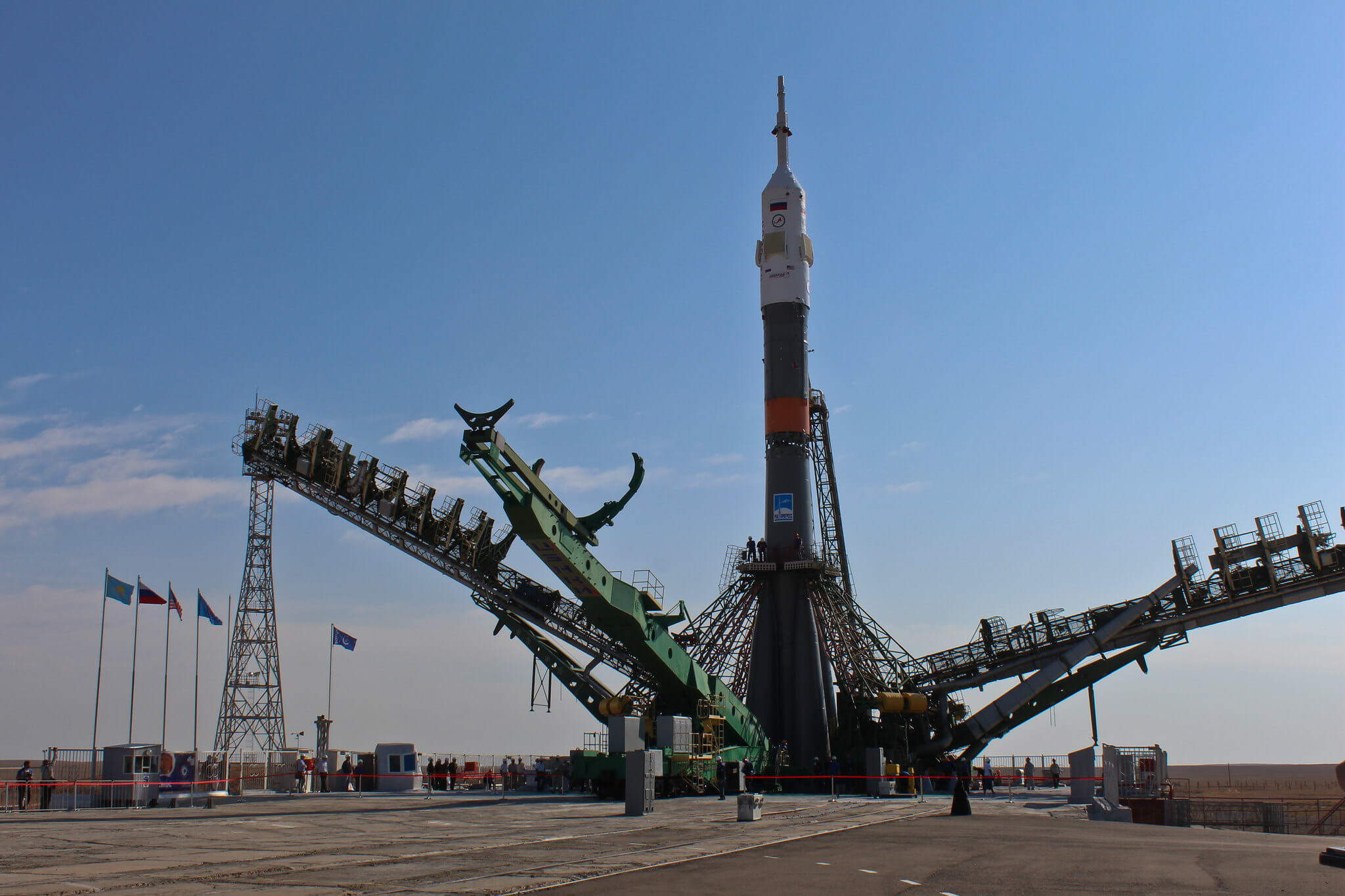Cosmodrome Baikonur – a launch experience
Info Shymkent made a visit into Cosmodrome Baikonur to experience real rocket launches.
Day 1 – The arrival
We reached the railway station Tjuratam after an over 500 kilometers ride from Shymkent by a night train on an early Saturday morning. We were warmly welcomed by our friend Oleg at the Tjuratam train station. After handshakes we went by his car and with the appropriate access documents to the city of Baikonur. Russia rents the ground of Baikonur Cosmodrome and city from Kazakhstan since the fall of the Soviet Union. So the city and also the Cosmodrome is surrounded by a huge wall and checkpoints at the street and rail exits.
After passing the checkpoints we went to a hostel. It is located on the top floor of a school. Our room was well equipped for Kazakh and Russian conditions. From the balcony of the hostel we had a wonderful view into the city.
By the way: The official name of Baikonur was Leninsk till 1995. Only the Cosmodrome Baikonur hold the name Baikonur from a Kazakh city Baykonur 300 km northeast of the Cosmodrome. They used the name to confuse the West from the real position of the spaceport.
After our long train ride through the yellow steppe, we immediately noticed the lush greenery planted by human hands in Baikonur. You can recognize by a closer look that this oasis is kept alive only by small blue or green water pipes. A precious commodity. It reminded us very fast on our flower oasis Shymkent.
In the late morning we strolled over the market of Baikonur. We immediately saw that we were not in a normal market. Many advertisements contained a Soyuz rocket in the center – even if only electronic goods or food was advertised. At the market stalls, rocket models, cups and T-shirts – related to the cosmodrome – were offered.
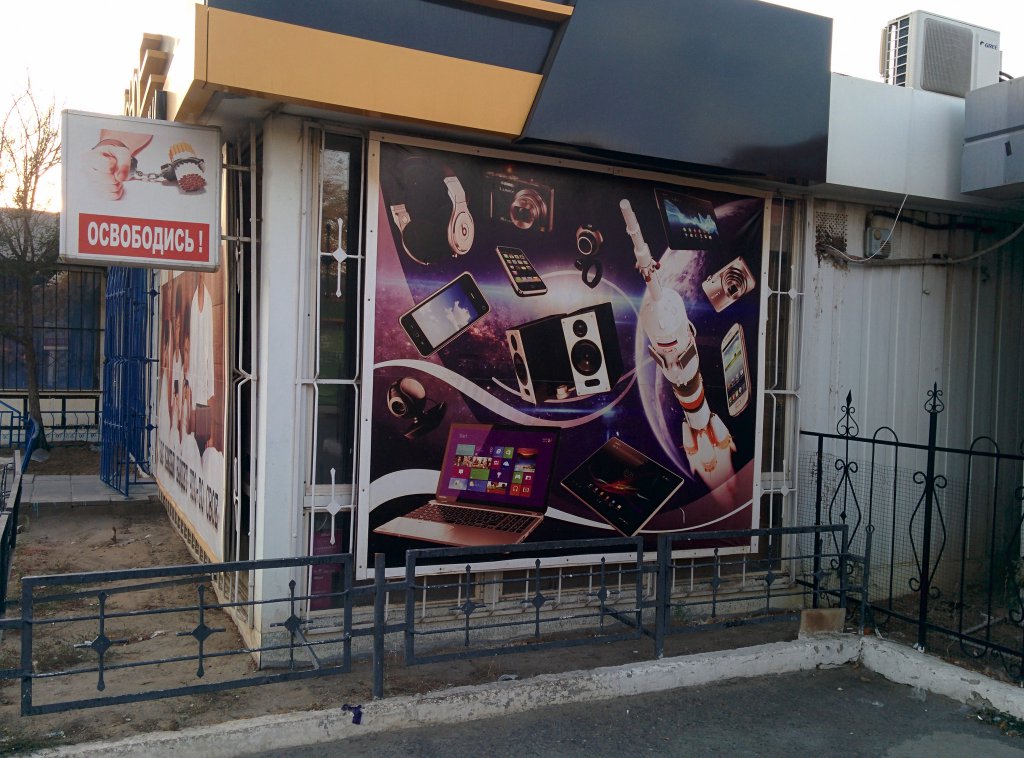
We also noticed on this Saturday in which isolated environment the Cosmodrome Baikonur is located when we made a bathing excursion to the popular bathing lake Kamyslybas. We drove 150 kilometers on almost straight roads through the endless, always the same looking steppe.

Only camels and sometimes horses appeared at the roadside. A sign announced: 1500 kilometers to the big city Samara in Russia. On this moment you can recognize that the site of the spaceport was truly a good hiding place for a rocket base in the south of the former Soviet Union during the Cold War.
Day 2 – Soyuz rollout in the Baikonur Cosmodrome
The night on Sunday went short. We had to get up early, because the roll-out of the Soyuz rocket is traditionally at dawn. We were picked up at the hostel and drove to the “Centralnaya” hotel for a simple breakfast consisting of russian porridge at 5am. The hotel is located directly at the main square of Baikonur. There is a big Lenin statue still greeting the guests of the city. We chatted with other guests from all over the world at the breakfast table.

We went by bus after meal into the Cosmodrome Baikonur for the first time. Thereby we passed again two checkpoints: One at the exit of the city and after a short drive on Kazakhan’s soil the other one at the entry into the restricted area. Inside of the Cosmodrome we drove a long road with the bus northwards. After the last lights of Baikonur disappeared behind the horizon, the illuminated halls appeared in the direction of our ride. We recognized that also in the past this area was protected from curious views from outside.
Our first trip went to Place 112. Inside of this huge building waited already the Soyuz rocket brightly illuminated. Many workers whirled around in the assembly building. The lighting of the locomotive was on shunting mode. Attached was a wagon with the rocket ready for the next manned mission. Everything was ready for the roll-out.
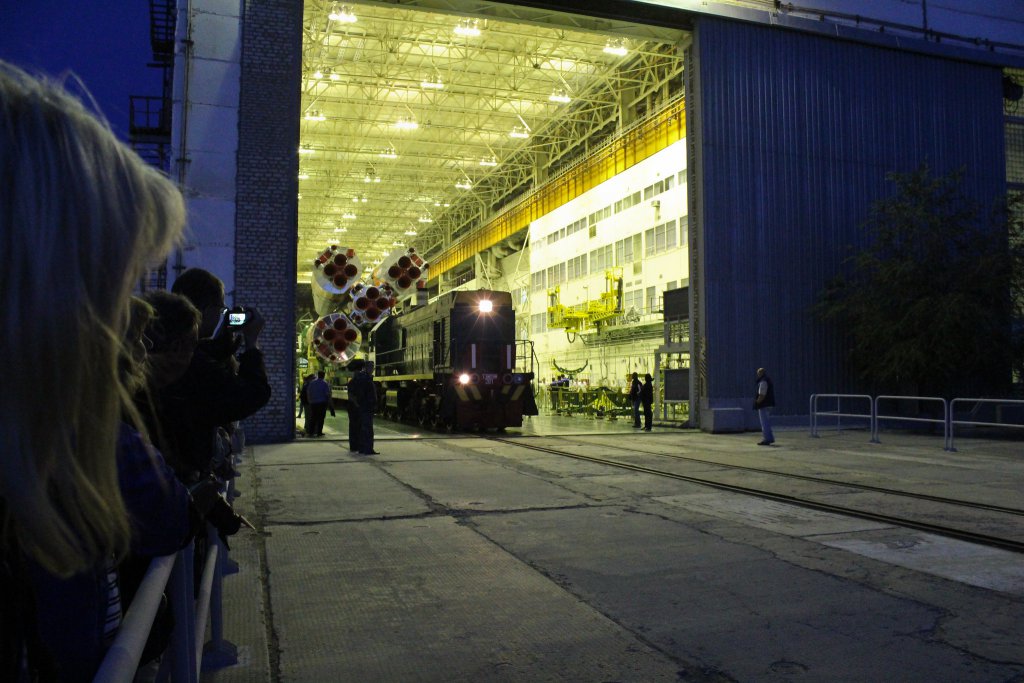
The Soyuz is being manufactured in serial production. We could see this clearly from the fact that there were first stages for a later launch in the assembly building. These parts were not yet been assembled. They will probably bring the next following crew to the International Space Station in three months.
We tourists stood in a line, armed with camera and smartphone, as the rocket, protected by security guards, rolled past us at walking pace. The sun had not yet risen and the rocket quickly disappeared in the direction of the first turning point, which is located behind the refuelling facilities of the russian Space Shuttle “Buran”.
We were now taken by bus to rail crossing near launch pad 1 (“Gagarin’s Start”), from where we could overlook the entire track of the rocket to the launch pad. The sun rose in the east behind the launch pad with the still open launch tower as we arrived the rail crossing. Beautiful. It immediately comes to our mind how appropriate the name of the first manned flight from this launch pad was chosen – “Vostok 1” (East 1).
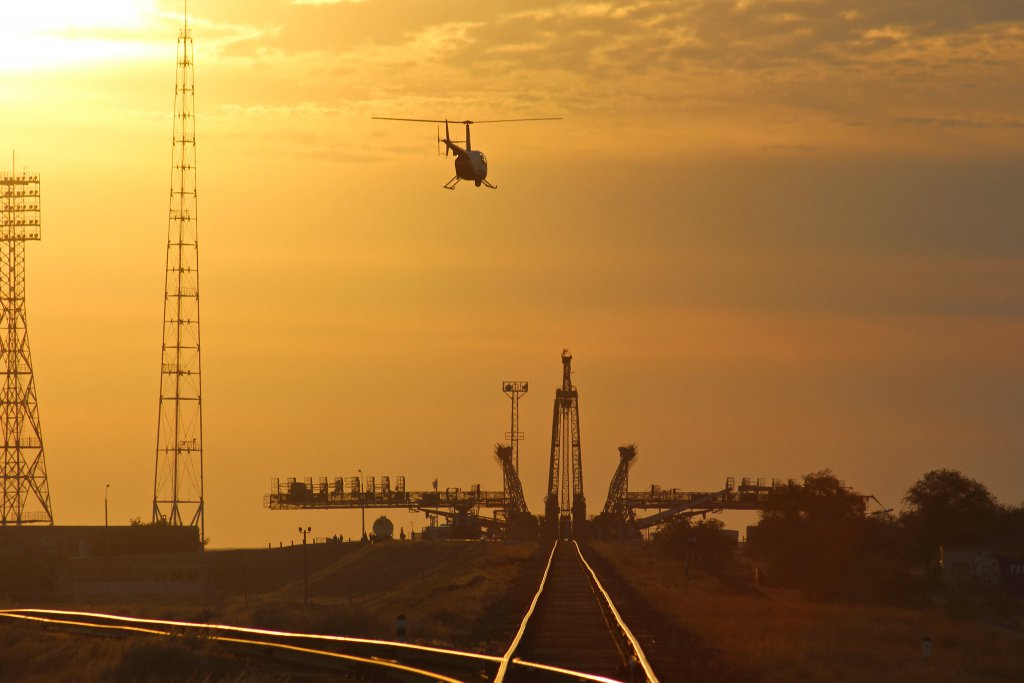
Then in the reddish morning light the rocket slowly rolled closer. First the rocket drove to the second turning point and then passing the rail crossing to the launch pad. This was the last time that we were so close to the rocket. The same distance as at Place 112 – the assembly hall. Only a few meters separated us from the Soyuz rocket.

The international audience was allowed to enter the launch pad after the rocket had reached the launch site and we could watch the rocket’s erection from horizontal to vertical position. Even a steppe fox wanted to watch this event and sneaked across the launch pad between the train transport cars and pipes of the launch pad.
After raising the transport wagon with the rocket on the launch pad, we could watch – faster than expected – the rocket disappearing into the launch tower. This was the moment we had to leave the Cosmodrome Baikonur by bus to go back into the city.
But there was another item on the program for Sunday: The visit to the International School of Baikonur. The school is very modern and – surprisingly for us – classes take place from Monday to Saturday.
The teaching facility is characterized by the fact that interesting space exhibits and models are located on each floor.
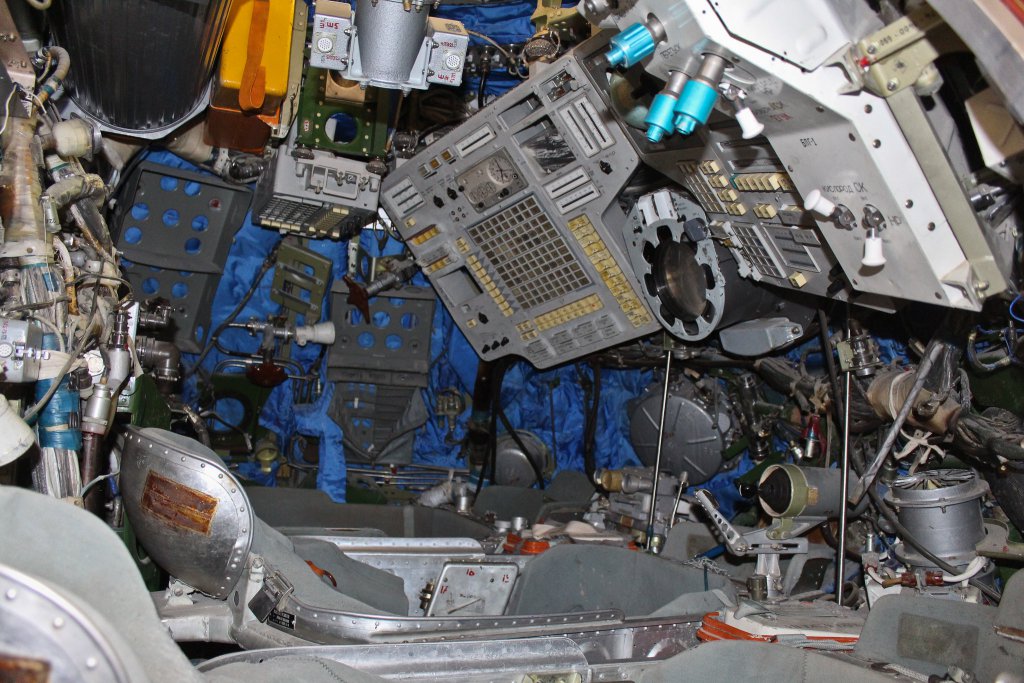
For example, there are several engines on the first floor and a TKS space capsule on the second floor. We were allowed to take place into the bucket seats of this capsule, and for a short moment we were allowed to feel like real cosmonauts.
At the end of the tour, a model rocket was launched for us in the courtyard of the international school. Only the second launch attempt was successful, and the model rocket landed on the roof, influenced by a strong crosswind. We thought to ourselves: Hopefully the start of the Soyuz will be better!
In the evening we had the opportunity to meet Oleg in our free time and to exchange the experiences of the day that was coming to an end. Oleg drove us to the the monument named “Fisherman” or “Zero gravity” at the entrance of Baikonur.
In front of this monument there are always numerous photos taken by the Soyuz crews.

Day 3 – Baikonur city tour
Monday morning started calmly. We were able to sleep after the last rather short nights and after breakfast in the “Tsentralnaya” we set out to discover the city of Baikonur on foot. Oleg had given us a few tips on the way the evening before.
We paid a visit to some of the monuments in the history of space: the horizontal Soyuz rocket to touch, the Gagarin and Koroljow memorial, the sleepy city park, the Russian Orthodox Church with its onion turrets and the closed gates of the quarantined cosmonaut hotel. Unfortunately, it was not possible to look over the fence at the avenue of cosmonauts.
We were also unable to take a look at Gagarin’s summer pavilion on Syr-Dariya, as it is currently being integrated into a new hotel complex and is hidden by very high fences. We were also able to experience the friendliness of the Baikonur residents: Bernhard and I were invited to the Baikonur sports complex. There he was allowed to prove himself for half an hour playing table tennis, while I was given a private tour of the sports facilities.
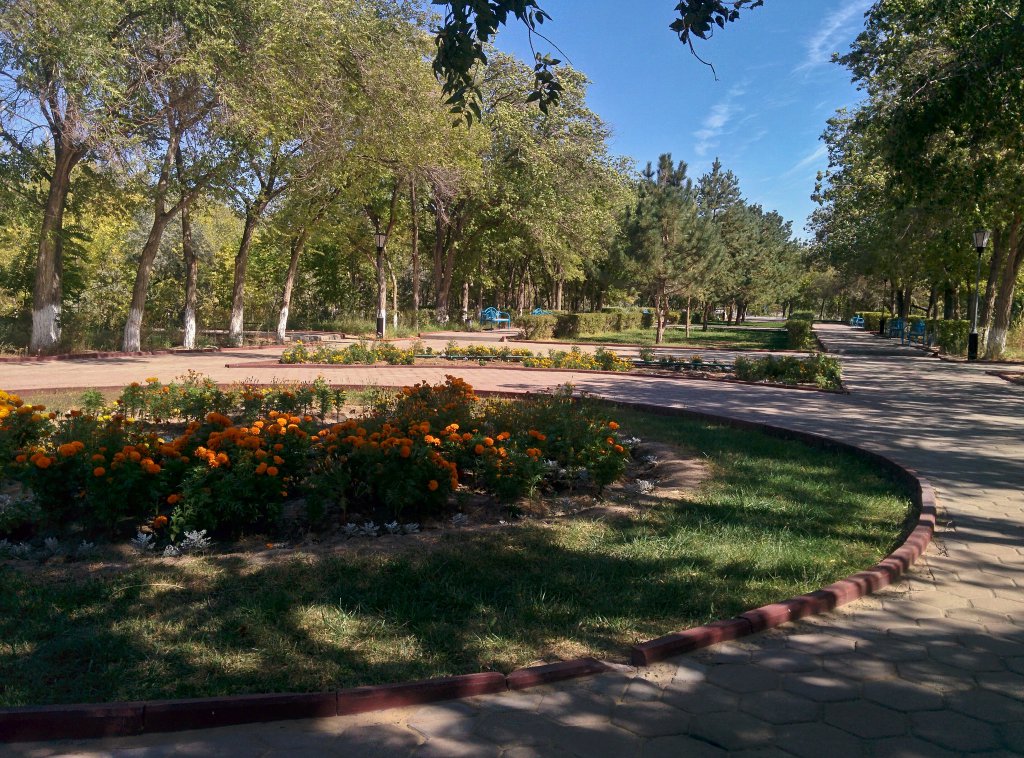
In the afternoon the regular program was resumed: First of all we went with the tourist bus to the cultural centre with the historical museum of Baikonur. Above all, many models and photos told the story of the creation of the cosmodrome and the city and described the development of the individual Russian-Soviet rockets and manned space vehicles up to today’s space station ISS. This was followed by a short city tour with many places already visited by us on foot.
For the evening there was still some cultural exchange on the agenda. Together with three other young travellers we were asked to accompany an English lesson in the language school located in the building of our hostel. So we talked to the Russian and Kazakh students about life in Kazakhstan and in Europe – a very nice insight into the cultures.
The upcoming night should be a little shorter for us again, because since our arrival we had been trying to find an optimal position for observing the launch of the “Proton” with a commercial communication satellite. Since we were not given the opportunity to observe the launch from the roof of our hotel, our translator organized a taxi for us. Together with a married couple from Germany we took this taxi to the vicinity of the border fence of the Cosmodrome Baikonur.
Far away from city and street lights we could observe the ignition of the rocket engines at 1am in the morning. The ascent of the powerful “Proton” was easy visible from a distance of about 46 km. The dark rumbling of the engines arrived us after three minutes into the flight. The change in the ascent path to the rocket from vertical to horizontal was visible very well. We were able to see the ignition and operation of the individual rocket stages clearly with the naked eye.
Day 4 – Cosmodrome Baikonur tour
After the short night, Tuesday was dedicated to discover the launch facilities of the Cosmodrome and the Soyuz launch. We took the bus to the spaceport after a short breakfast in the central hotel. The first stop was at the Museum of the Cosmodrome. Here we could watch the signed mission flag and the mission picture of the crew of the Soyuz-MS mission.
There is also a kind of “Hall of Fame” with all the cosmonauts launched from the Cosmodrome Baikonur so far.
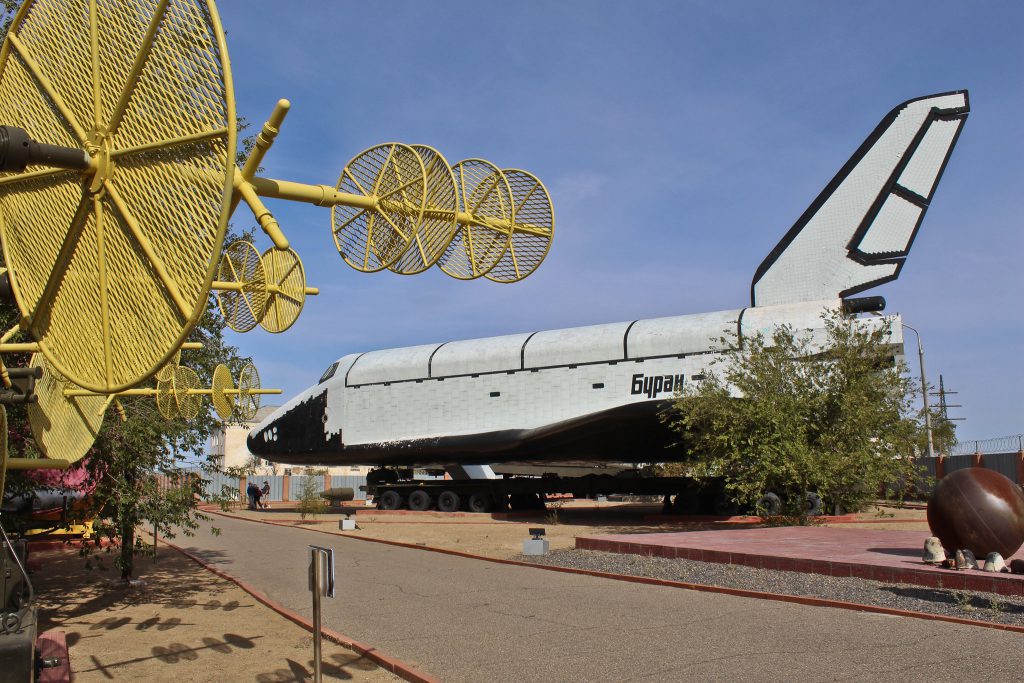
There are two small, freshly reconstructed houses of Gagarin and Koroljow next to the museum. Because of the completely preserved interior decoration, I had the feeling that a cosmonaut of the first cosmonaut group would enter the room right now.
After two hours in the museum we went deeper into the cosmodrome. Our destination was the control center of the Buran, the Soviet equivalent of the US-American space shuttle. The control center is located in Building 60 on Place 250A. Building 60 is a bunker rather than a building. After passing through thick armored doors and long corridors with thick walls we entered the control room.
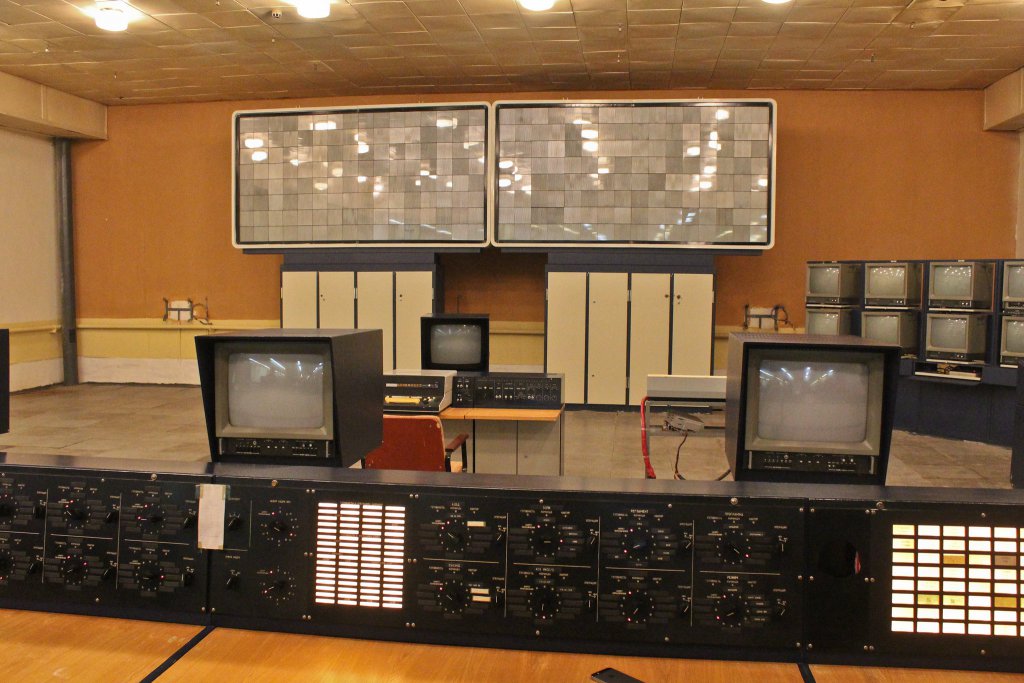
It surprised us very much, there were still an intact control and fire room with computer cabinets and consoles from the end of the 1980ies. We were not informed about the individual functions of each console unfortunately, so we had to speculate a little bit with our small knowledge of the Russian science language. It was nice that we’ve got the permission to simply play around with the unique historical material and had a closer look.
Back in the bus we drove to the launch pad Place 31, passing the huge remains of the two launch complexes of the space shuttle Buran and the rest of a launch tower of the N1 – the unsuccessful soviet moon rocket. During passing by at the integration building of the Buran we clearly saw the heavy damages of the roof. It is unbelievable that under the rubble of the crashed roof is the only soviet space shuttle Buran which went to space.
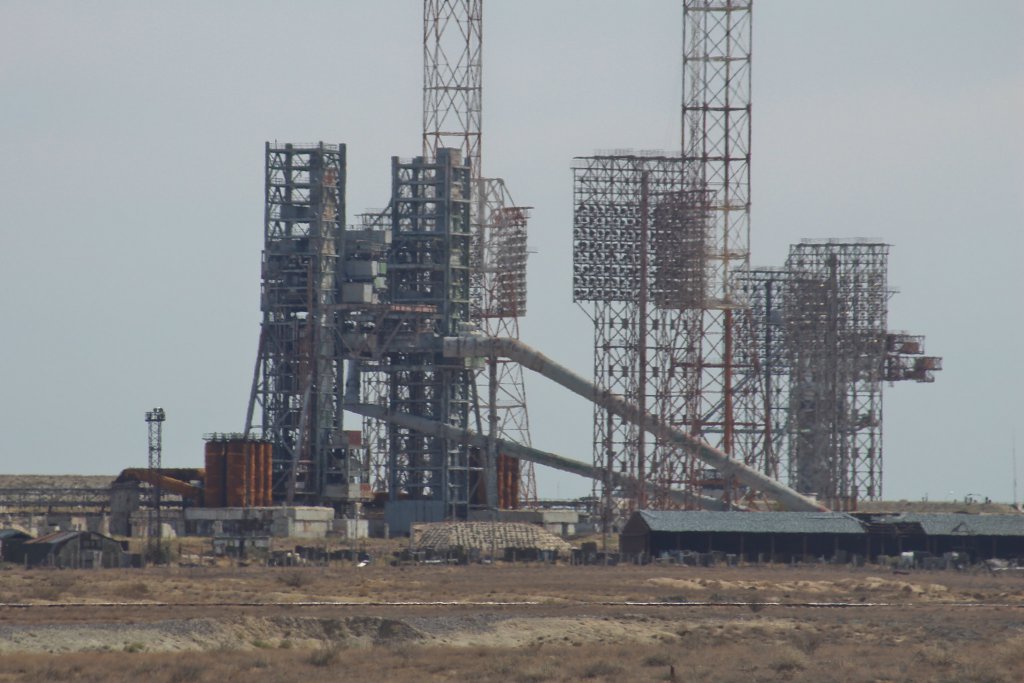
After we passed Place 112 again, we went far to the east of the cosmodrome, where the launch pad Place 31 is located. During the trip we could also observe some camel along and even on the road.
The launch pad Site 31 is basically a copy of Gagarin’s launch pad. Launch pad Site 31 was built at a later date. So also some improvements have already been made here. The integration buildings are located very close to the launch site and the flame trench is smaller as Gagarin’s launch pad.
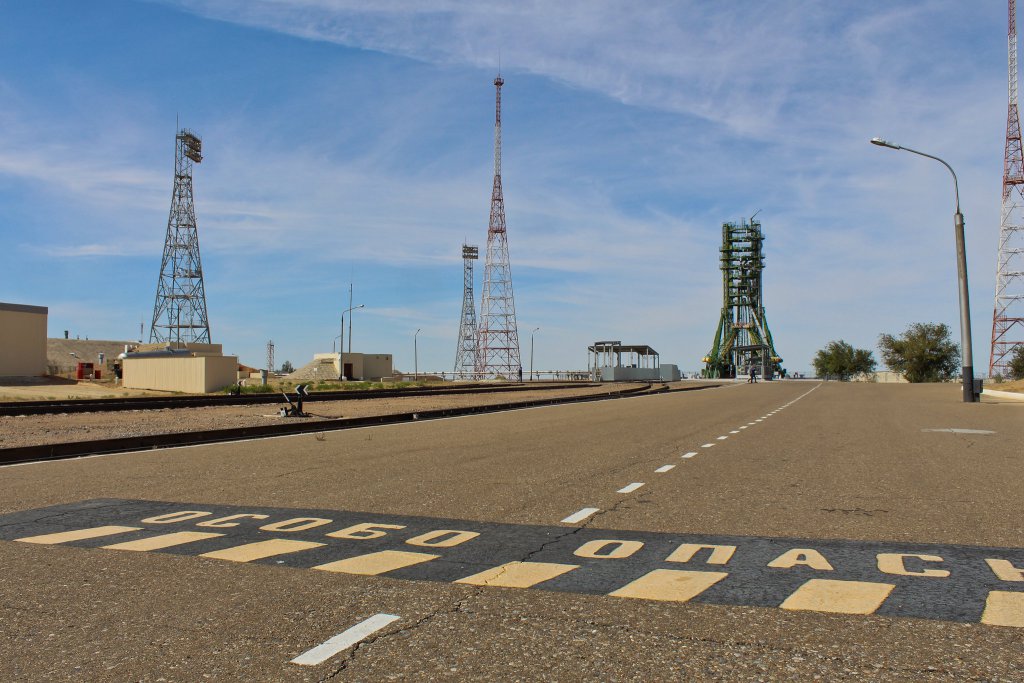
Unfortunately we could not enter the launch site. We would like to inspect the empty launch tower and also wanted to have a look into the flame trench. But we had to take what we get: So we only got a few zoom shots and a few group and single pictures in front of Site 31 for the photo album. Afterwards we went back to the city Baikonur.
To be prepared for the highlight, the night launch of the Soyuz, we could sleep a little bit. After a short nap we had to say “Goodbye” to Oleg, our friend and supporter for our special short trip. We exchanged small gifts and drank the last drinks before the rocket launch.
Around 9:30 am – after sunset – we were picked up again by our tour guide by bus and we went the last time into the cosmodrome. The first stop was still in the city: After the Soyuz crew left their homes to prepare for their trip to the International Space Station we could enter the area of the cosmonaut hotel and visit the Avenue of the Cosmonauts. As a tradition each space Traveller plants a tree before his first launch. If he flies into space a second time, he may just water his tree.
In the dark, the search for a few trees of selected astronauts turned out to be very difficult. The trees of the ESA astronauts Gerst, Flade, Cristoferetti, the record-holder for the longest stay in space Padalka and space tourist Simony we could find. But unfortunately the trees of the first Kazakh and the first German could not be identified. Next time we are better prepared…
After only 15 minutes, which we had spent with the search game, we went into the Cosmodrome. Our Soyuz flight was a manned flight, so we wanted to see the cosmonauts at least once from a close distance. We’ve got a few seats in the first row on a small place after a short security check. It is the square for the final Check of the flight readiness of the Cosmonauts. We were proud to be here – because it’s only possible for a small amount of tourists, press representatives, officials and relatives of the astronauts to take part of the ceremony. After some waiting in the very cold Kazakh night, the crew in their white-blue Sokol space suits came out of the building synchronously and took their last steps on earth for the next upcoming months.
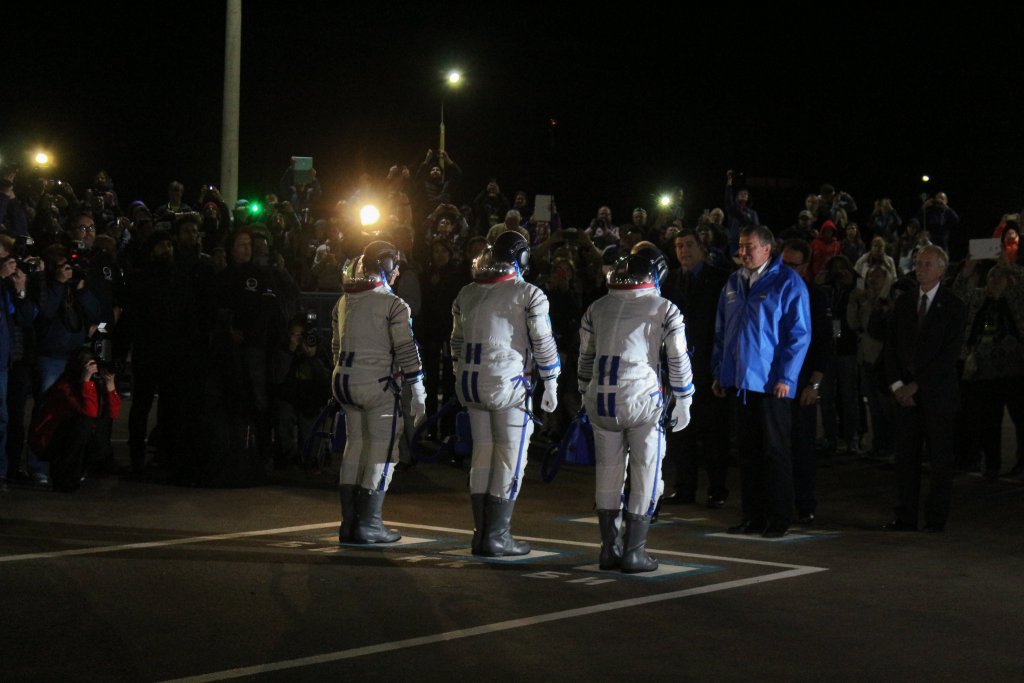
After the usual short dialogue, the crew quickly boarded the bus that took them to the launch pad. It’s a pity we could not go into the bus as well. But instead of climbing into a Soyuz capsule, we were allowed to study the museum of the Cosmodrome Baikonur more closer and take over the control of cockpit of the space shuttle Buran. There was also time to buy some souvenirs like a model rocket, a t-shirt or even space food. In a relaxed atmosphere we chatted with other international guests and drank a little coffee to not fell asleep in this long night.
Day 5 – Soyuz rocket launch day
At about half past one in the morning the signal came finally to leave the museum to got a view onto the rocket. The new visitor platform houses a huge tent where you can warm up on cold nights, as well as a huge LED video wall with live transmission of the Soyuz launch. We preferred the direct and excellent view outside of the tent of course. So outside it was possible to watch the highlight of our journey from only a distance of about 1,300 meters: the Soyuz rocket, which was illuminated with powerful spotlights and was already steaming heavily due to the cold fuels.
The rocket with the crew on top was ready to take off. We weren’t ready, too. We made a few photos and talked with other visitors very much and almost missed the launch. So it was great that the retraction of the refuelling arm gave a sign of the approaching launch. During the launch the launch pad was put into very bright blinding light.

We felt the heat and after a few seconds we heard and felt the rocket’s roar as it ignited the engines. Because we were very close to the launch pad we could look directly into the rocket engines, similar to a starting New Year’s Eve rocket. What a sight! But after a few minutes the manned Soyuz had already shrunk to a small dot and was moving away to the eastern horizon.
It was already time to leave for the hotel, five minutes after the launch. Back in the hostel last business cards were exchanged, then the breakfast package was received and finally the things were packed. After five very nice and impressive days in Cosmodrome Baikonur we left the spaceport at the Tjuratam station to going back to Shymkent by train.
We could recommend everyone to experience a rocket launch. It’s just amazing and a life experience!



